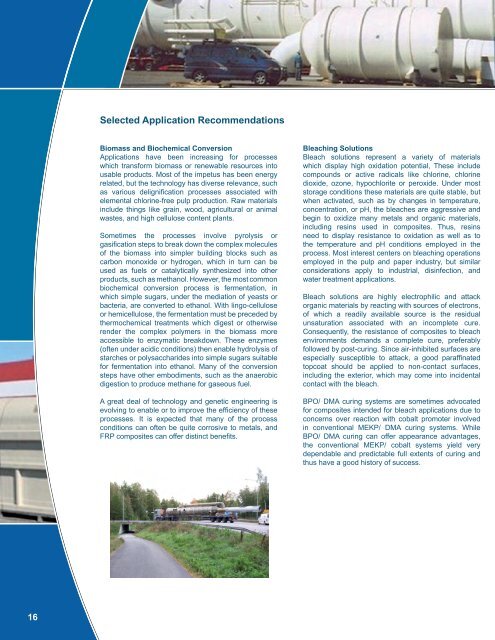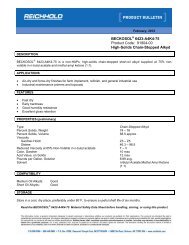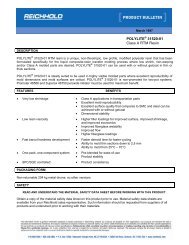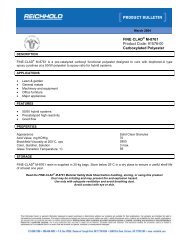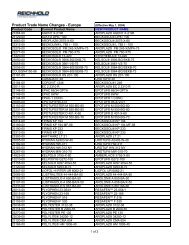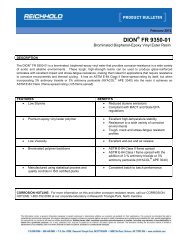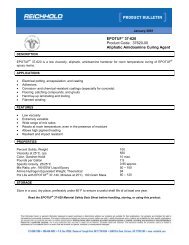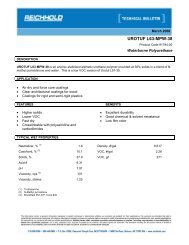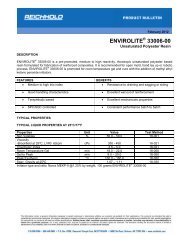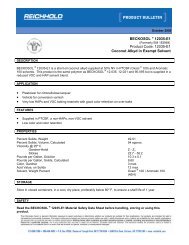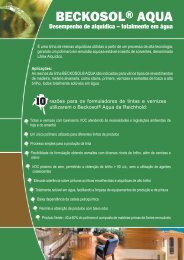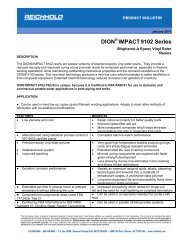CORROSION GUIDE 181108_new table content format ... - Reichhold
CORROSION GUIDE 181108_new table content format ... - Reichhold
CORROSION GUIDE 181108_new table content format ... - Reichhold
Create successful ePaper yourself
Turn your PDF publications into a flip-book with our unique Google optimized e-Paper software.
Selected Application Recommendations<br />
Biomass and Biochemical Conversion<br />
Applications have been increasing for processes<br />
which transform biomass or re<strong>new</strong>able resources into<br />
usable products. Most of the impetus has been energy<br />
related, but the technology has diverse relevance, such<br />
as various delignifi cation processes associated with<br />
elemental chlorine-free pulp production. Raw materials<br />
include things like grain, wood, agricultural or animal<br />
wastes, and high cellulose <strong>content</strong> plants.<br />
Sometimes the processes involve pyrolysis or<br />
gasifi cation steps to break down the complex molecules<br />
of the biomass into simpler building blocks such as<br />
carbon monoxide or hydrogen, which in turn can be<br />
used as fuels or catalytically synthesized into other<br />
products, such as methanol. However, the most common<br />
biochemical conversion process is fermentation, in<br />
which simple sugars, under the mediation of yeasts or<br />
bacteria, are converted to ethanol. With lingo-cellulose<br />
or hemicellulose, the fermentation must be preceded by<br />
thermochemical treatments which digest or otherwise<br />
render the complex polymers in the biomass more<br />
accessible to enzymatic breakdown. These enzymes<br />
(often under acidic conditions) then enable hydrolysis of<br />
starches or polysaccharides into simple sugars sui<strong>table</strong><br />
for fermentation into ethanol. Many of the conversion<br />
steps have other embodiments, such as the anaerobic<br />
digestion to produce methane for gaseous fuel.<br />
A great deal of technology and genetic engineering is<br />
evolving to enable or to improve the effi ciency of these<br />
processes. It is expected that many of the process<br />
conditions can often be quite corrosive to metals, and<br />
FRP composites can offer distinct benefi ts.<br />
Bleaching Solutions<br />
Bleach solutions represent a variety of materials<br />
which display high oxidation potential, These include<br />
compounds or active radicals like chlorine, chlorine<br />
dioxide, ozone, hypochlorite or peroxide. Under most<br />
storage conditions these materials are quite s<strong>table</strong>, but<br />
when activated, such as by changes in temperature,<br />
concentration, or pH, the bleaches are aggressive and<br />
begin to oxidize many metals and organic materials,<br />
including resins used in composites. Thus, resins<br />
need to display resistance to oxidation as well as to<br />
the temperature and pH conditions employed in the<br />
process. Most interest centers on bleaching operations<br />
employed in the pulp and paper industry, but similar<br />
considerations apply to industrial, disinfection, and<br />
water treatment applications.<br />
Bleach solutions are highly electrophilic and attack<br />
organic materials by reacting with sources of electrons,<br />
of which a readily available source is the residual<br />
unsaturation associated with an incomplete cure.<br />
Consequently, the resistance of composites to bleach<br />
environments demands a complete cure, preferably<br />
followed by post-curing. Since air-inhibited surfaces are<br />
especially susceptible to attack, a good paraffi nated<br />
topcoat should be applied to non-contact surfaces,<br />
including the exterior, which may come into incidental<br />
contact with the bleach.<br />
BPO/ DMA curing systems are sometimes advocated<br />
for composites intended for bleach applications due to<br />
concerns over reaction with cobalt promoter involved<br />
in conventional MEKP/ DMA curing systems. While<br />
BPO/ DMA curing can offer appearance advantages,<br />
the conventional MEKP/ cobalt systems yield very<br />
dependable and predic<strong>table</strong> full extents of curing and<br />
thus have a good history of success.<br />
16


